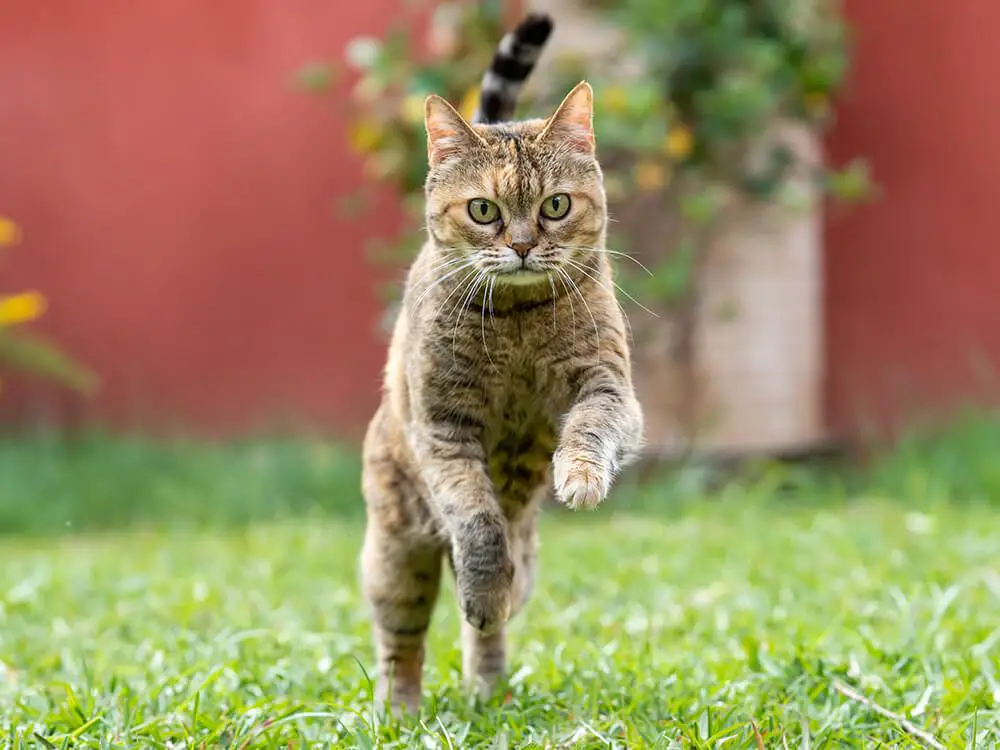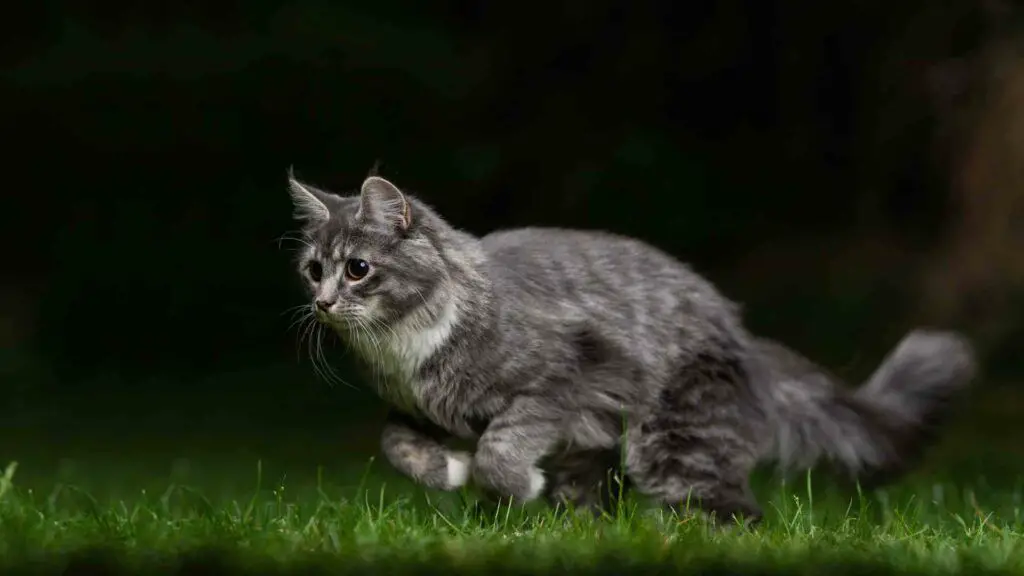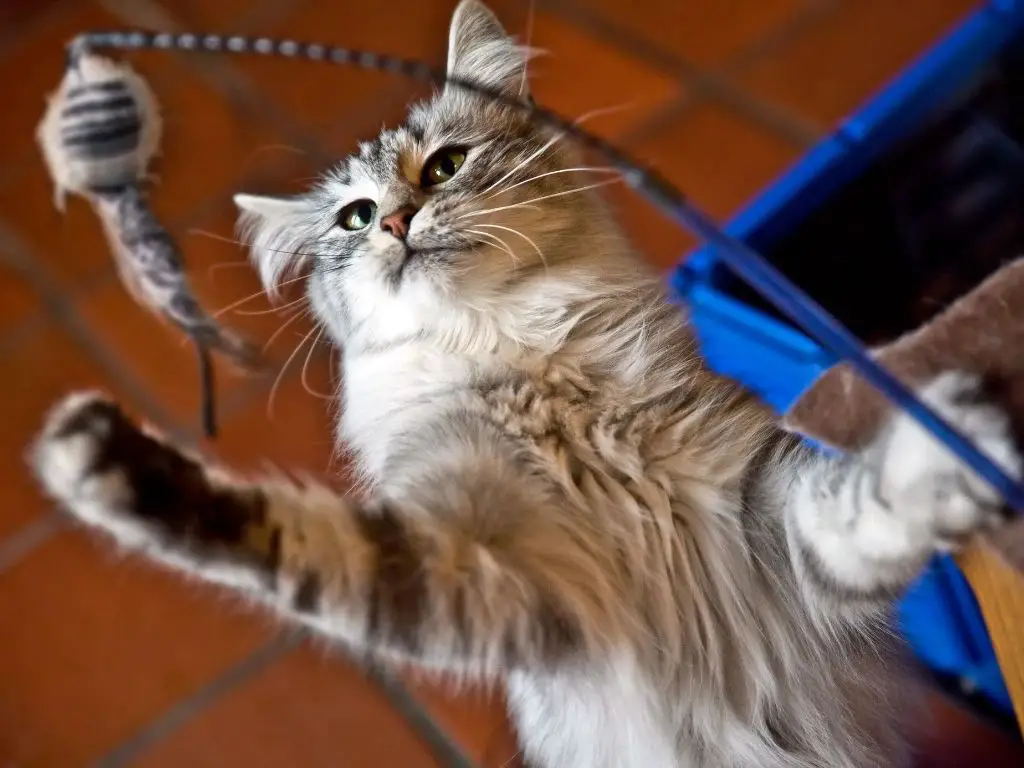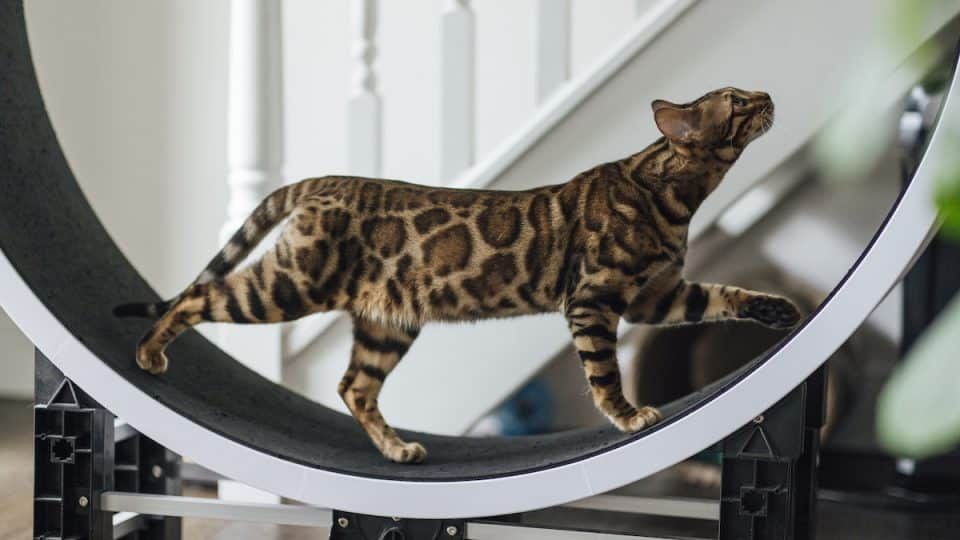What Are Cat Zoomies?
Cat zoomies are periods of frantic activity in which a cat will suddenly begin running around the house at high speed, jumping on and off furniture, and engaging in other energetic and seemingly random behavior (https://www.vetvoice.com.au/articles/why-does-my-cat-get-the-zoomies/). The name “zoomies” comes from the cat’s fast zooming or running during these hyperactive episodes.
Zoomies are characterized by rapid sprints, jumping, climbing, rolling, leaping, darting back and forth, meowing, and just generally exhibiting excitable and unrestrained behavior (https://www.dailypaws.com/cats-kittens/behavior/common-cat-behaviors/cat-zoomies). It’s as though they are suddenly overtaken by a burst of energy and frantically race around the home.
During zoomies, the cat will have dilated pupils, be highly vocal, and be completely absorbed in their energetic activities. It may seem like random chaotic behavior to us, but it is the cat’s way of blowing off steam and releasing pent up energy.
Why Do Cats Get the Zoomies?
Cats experience “zoomies” due to pent-up energy that needs a quick release. Although cats sleep 12-16 hours a day to conserve energy, their active awake periods build up a surplus of physical and mental energy. Zoomies allow a cat to engage in fast-paced, exaggerated play that burns through this excess energy in a short burst. This explains why cats often get the zoomies first thing in the morning after sleeping all night or in the evening after resting most of the day.
According to Four Paws, zoomies are “one of the most common reasons why cats get the zoomies. For the most part, it’s just a completely normal expression of their quirky personality!” (https://www.fourpaws.com/pets-101/cat-corner/cat-zoomies-explained). An indoor cat may experience more frequent or intense zoomies due to limited outlets for physical activity and predatory play. Outdoor access provides more opportunities to run, climb, hunt, and release pent-up energy in a natural environment.
The need for a pressure release through zoomies can also arise after a stressful event like a visit to the vet according to Daily Paws. The exaggerated play allows a cat to shake off the experience and get back to their normal routine (https://www.dailypaws.com/cats-kittens/behavior/common-cat-behaviors/cat-zoomies). Zoomies are generally considered a healthy behavior in cats when exhibited in moderation.

At What Age Do Kittens Start Zooming?
Kittens generally start exhibiting zoomie behavior around 2-3 months of age. At this young age, kittens have high energy levels and lots of curiosity, which leads to excited running, jumping, and playing. Zooming around helps kittens burn off excess energy. Many experts note that 8-12 weeks is when zoomies tend to begin (https://figopetinsurance.com/blog/when-do-kittens-calm-age).
The zooming stages seem to start once kittens gain better coordination and confidence in their physical abilities. As their motor skills improve through playing and practice, kittens start speeding and leaping around the home. Hardwood floors and other slick surfaces often bring out the zoomies too. Kittens may intermittently zoom around for a few minutes at a time as they test out their energy and athleticism.
In summary, cat parents can expect kittens to start their zoomie adventures around 2-3 months of age. But each kitten is an individual, so first zoomies may begin a bit earlier or later. Either way, the zooms signal kittens growing up and burning energy in fun kitten fashion!
Do Zoomies Decrease With Age?
Zoomies are a common behavior in kittens and young cats, who have an abundance of energy to burn. As cats mature into adulthood, zoomie sessions tend to become less frequent and intense. By the time cats reach senior age, zoomies may occur only occasionally or stop altogether.
Kittens and juvenile cats are extremely energetic and playful. During this stage of rapid development and growth, kittens especially will zoom frequently – sometimes many times a day. Young adult cats up to around 2 years old also commonly get the zoomies as they play and burn off energy.

In middle-aged adult cats, zoomies tend to decrease in frequency. A typical adult cat may zoom every few days or weekly. Zoomie sessions are usually shorter and less frantic than in kittens. As cats pass 5-10 years old, their energy levels decline naturally. Joint pains and mobility issues may also develop, making zooming more difficult.
Senior cats over 10 years old rarely zoom, if at all. However, some sources note that very occasional zooming in senior cats may indicate cognitive decline or related conditions like CDS. So while less frequent, senior cat zoomies can still signal an underlying health issue.
Overall, most cats do “mellow out” as they leave kittenhood. Their zoomie frequency and intensity decreases with age due to maturity, lower energy, and physical limitations. But zoomies can persist occasionally into middle or even senior age, especially when cats are playing or excited.
When Are Zoomies Most Common?
Cat zoomies tend to occur most often in the evening and at night. Many cats experience a burst of energy right before bedtime, racing around the house in wild abandon. This nighttime madness frequently happens between the hours of 7pm and midnight when cats are naturally most active. Kittens and younger cats especially tend towards evening zoomies since they have so much kitten energy to burn. Zooming attacks may also happen first thing in the morning as cats wake up from long naps full of pent-up energy. Cats are crepuscular, meaning they are most active at dawn and dusk. This primal instinct leads to frenzied playtime during our morning and evening routines when cats are wired to hunt.
In addition to dawn and dusk, zoomies often happen right after cat naps. Our feline friends sleep over 15 hours a day on average, storing up energy between catnaps. When they awake, they release their wild side in a flurry of sprints and pounces. Cats may also zoom after pooping, as the physical act of elimination fills them with a burst of energy. Zoomies can even occur after eating, as cats burn off the calories from their meal. High energy activities like playing with toys or engaging in hunting behaviors can likewise trigger a feline freakout.
How Long Does a Zoomie Session Last?
The typical duration of a zoomie bout is usually quite brief, lasting just 1-2 minutes according to most cat owners. However, some cats can have more prolonged sessions lasting up to 5 minutes or slightly longer on occasion. According to Reddit user u/sandypeople1 in this thread, their cat can zoom nonstop for 3+ hours before finally settling down. While not typical, some cats do seem prone to marathon zoomie sessions from time to time.
In general, most cats will only zoomie for a minute or two before taking a break. Zoomies are intense bursts of energy, so cats can’t maintain that level of exertion for too long. The longest zoomie sessions tend to occur in younger kittens and adolescent cats who have abundant energy. As cats mature, their zoomie bouts usually decrease in frequency and duration.
Can I Stop My Cat’s Zoomies?
While zoomies are a natural feline behavior, some cat owners wish to curb or prevent frequent zoomie sessions, especially zoomies that occur at night and disrupt sleep. Here are some tips that may help:
Schedule interactive playtime and exercise during the day to tire your cat out before bedtime. Try fishing pole toys that make your cat run and jump. Just be sure to stop strenuous play at least 2 hours before bed so your cat can calm down.
Leave out self-play toys like balls, toy mice, and treat puzzles when you’re not home or awake. This provides mental and physical stimulation.

Feed your cat smaller meals spaced throughout the day rather than one large meal. This prevents energy peaks and crashes.
Use calming pheromones like Feliway to help relax your cat before zoomie-prone times.
Keep your cat’s routine consistent with set mealtimes, playtimes, and bedtimes. Cats thrive on predictability.
Make sure your cat has plenty of vertical space to climb and perches to survey their domain. Lack of climbing outlets can contribute to zoomies.
If zoomies happen at a certain time of day, try distracting your cat with a toy or treat at that time to break the pattern.
While zoomies can’t be fully prevented, these tips can reduce frequent and disruptive zoomie sessions.
Are Zoomies Harmful for Cats?
Although zoomies are generally harmless, there are some potential risks with very frequent or intense zooming sessions, especially for older cats.
Frequent high-speed running and jumping during zoomies can put extra strain on joints and muscles. Older cats or those with existing arthritis may be prone to injury or soreness after intense play. Kittens should also be monitored since their bodies are still developing.
Additionally, zoomies that involve frantic sprinting up and down stairs or jumping on and off furniture can potentially lead to sprains or falls. Some cats become so excited during zoomies they lose awareness of their surroundings.
Excessive late night zooming can disrupt normal sleep patterns for both cats and their owners. Limiting zoom sessions at night and providing enough stimulating playtime earlier in the day can help avoid this.
In most cases, regular zoomies are completely normal and healthy for cats. But monitoring frequency and intensity, especially in senior cats, can help prevent injuries or soreness. Providing adequate exercise and playtime can also curb excessive zooming episodes.
Exercising Your Zoomie Cat
Zoomie cats often need more exercise outlets than their less energetic feline counterparts. Providing appropriate exercise opportunities can help reduce or redirect some of that frenetic energy in healthy ways. Here are some tips for exercising a zoomie cat:
Establish a regular play routine with your cat using interactive toys like wands, balls, and puzzle feeders. Schedule at least two 15-20 minute play sessions per day to help satisfy your cat’s prey drive. Rotate toys to keep things interesting. Catnip can also help spark playtime excitement.
Consider getting a cat wheel or treadmill so your cat can get exercise on their own terms. Place it in an area your cat frequents and reward them for using it.

Build a catio or cat enclosure so your cat can enjoy safe outdoor access. Place platforms, scratchers, and toys inside to encourage activity. Supervise time outdoors.
Use food dispensing toys like puzzle feeders. These provide mental and physical stimulation as cats bat and roll them around to get treats out.
Set up cat shelves, towers, and scratching posts around your home so your cat can climb and scratch. Vertical space allows cats to expend energy.
Harness train your cat for walks around your home or yard. Let them set the pace and stop to explore. Always reward calm behavior.
Consider adopting a second pet if your cat enjoys feline company. Interactive play between cats can help tire them out.
Bottom line – zoomie cats thrive with outlets for their energy. Providing appropriate exercise prevents boredom and destructive behaviors.
When to See the Vet About Zoomies
While zoomies are normal feline behavior, there are some signs that may indicate an underlying medical issue. According to Hill’s Pet Nutrition, you should contact your vet if your cat’s zoomies:
- Happen much more frequently or intensely than normal
- Cause your cat to run into walls, furniture, or people
- Lead to aggressive biting or scratching
- Occur together with other behavioral changes like house soiling or hiding
Dramatic increases in zooming activity, especially in mature cats, can signify conditions like hyperthyroidism, cognitive decline, or compulsive disorders according to Fetch Pet Care. If your cat’s zoomies seem distressed, painful, or coincide with changes in appetite, activity, or socialness, take them to the vet for examination.
Veterinary assessment can identify any underlying illness and provide treatment to improve your cat’s quality of life. With professional guidance, you can curb harmful zooming behaviors and channel your cat’s energy into healthy playtime.

